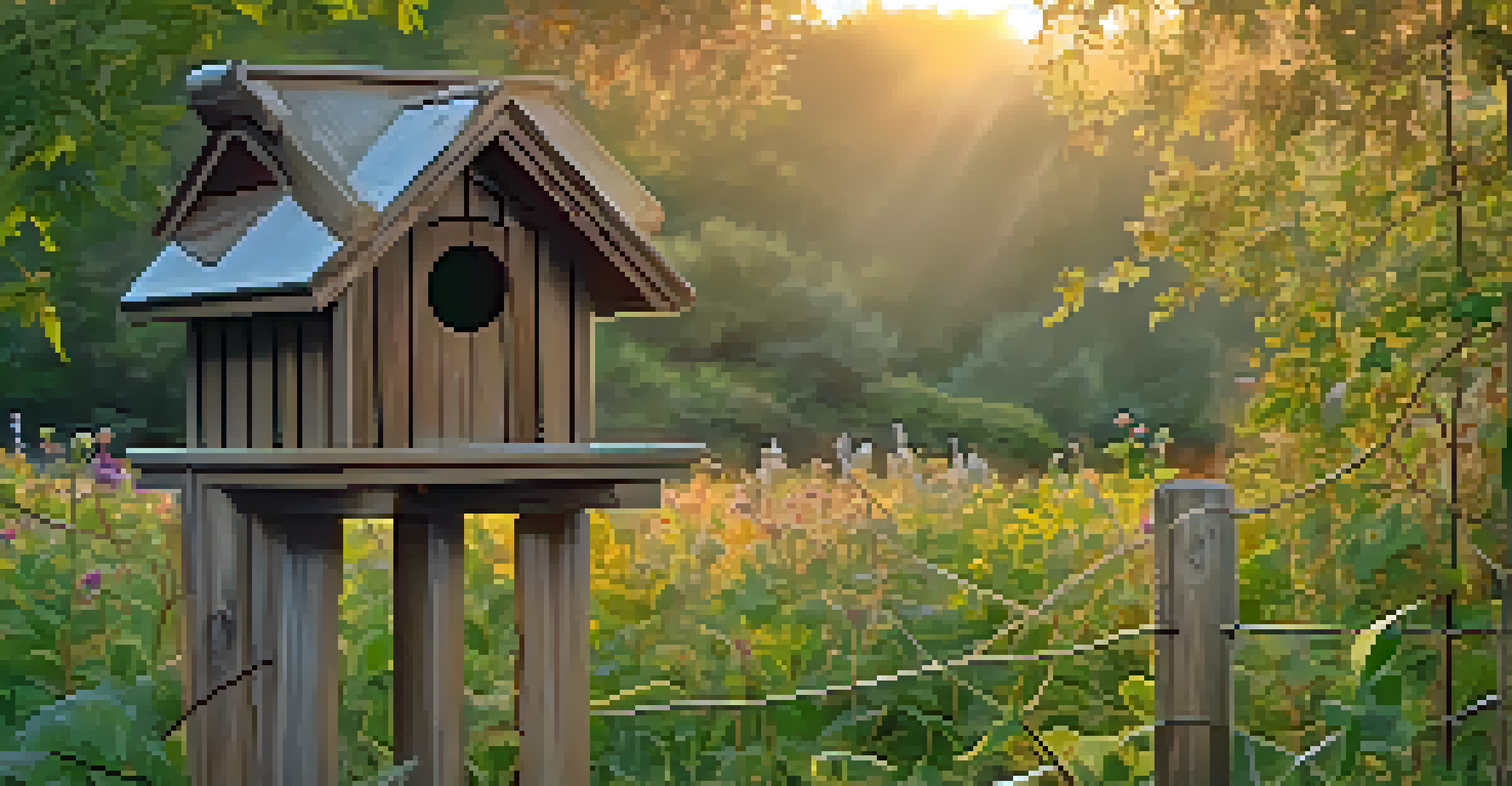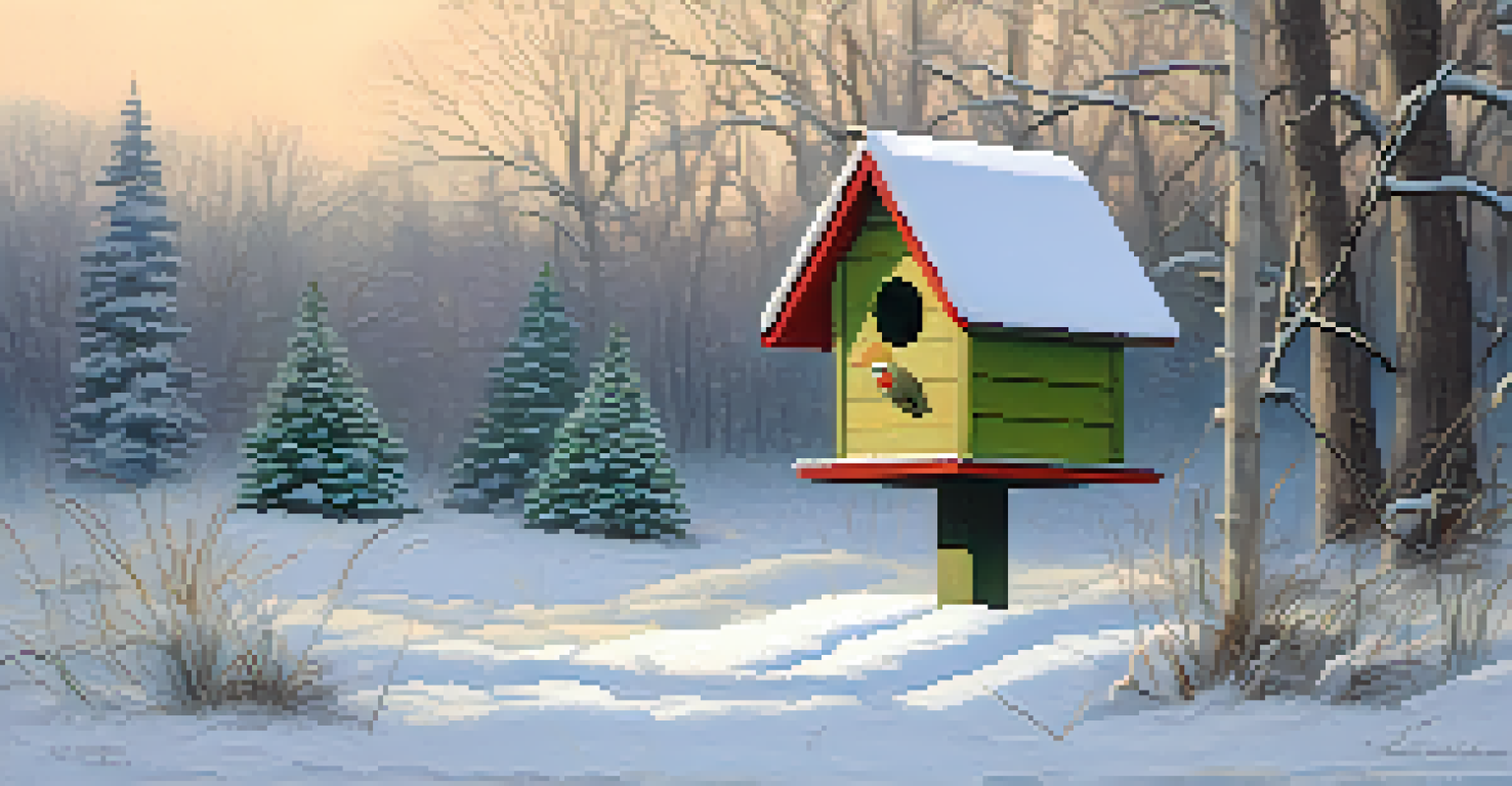Birdhouse Placement: Where to Hang for Maximum Attraction

Understanding Birdhouse Orientation for Success
The orientation of a birdhouse can significantly influence its appeal to birds. Ideally, the entrance hole should face away from prevailing winds and direct sunlight, providing a sheltered environment. This orientation not only keeps the interior temperature stable but also offers protection from predators and harsh weather.
The birdhouse is a little home for the birds. It offers shelter, safety, and a chance to nurture their young.
Consider the natural landscape around the birdhouse. For example, positioning the entrance towards trees or shrubs can provide birds with quick escape routes if they sense danger. Additionally, this setup can enhance their comfort, making your birdhouse more inviting.
Keep in mind that different species have varying preferences for orientation. For instance, wrens often favor houses that face east, while bluebirds are more adaptable. Understanding these nuances can help you tailor your placement strategy to attract specific bird species.
Choosing the Right Height for Your Birdhouse
Height is a crucial factor when it comes to birdhouse placement. Most small birds prefer their homes to be around 5 to 10 feet off the ground, allowing them to feel secure from ground predators. However, larger birds, like owls or kestrels, may require higher placements, sometimes reaching up to 30 feet.

Consider the trees and structures in your yard when selecting height. If you have a tall tree, hanging the birdhouse higher can mimic their natural nesting sites. On the other hand, if your yard is more open, a lower placement may be more suitable to attract ground-nesting birds.
Birdhouse Orientation Matters
Positioning the entrance hole away from prevailing winds and direct sunlight enhances shelter and comfort for birds.
Always ensure that the birdhouse is stable and secure at the chosen height. A wobbly house can deter birds from nesting, as they seek a safe and reliable environment. Using sturdy mounting methods can make a big difference in attracting feathered friends.
Finding the Perfect Location in Your Yard
The ideal location for a birdhouse combines safety, accessibility, and visibility. Look for a spot that has a mix of open space and nearby cover, like trees or shrubs, as this creates a balanced environment for birds. This way, they have the freedom to explore while also having a safe place to retreat.
Nature does not hurry, yet everything is accomplished.
Avoid placing birdhouses near busy areas, such as high-traffic paths or playgrounds. Birds tend to shy away from loud noises and human activity. Instead, situate your birdhouse in a quieter corner of your yard, where birds can feel relaxed and undisturbed.
Additionally, consider the proximity to food sources. If you plant native flowers or have a bird feeder nearby, it increases the chances of attracting birds. A well-placed birdhouse near these resources can turn your yard into a bustling avian habitat.
Avoiding Predators: Tips for Safe Placement
Predators can pose a significant threat to nesting birds, making it essential to place your birdhouse wisely. To deter predators like cats or raccoons, avoid placing the birdhouse too close to fences, trees, or shrubs that provide easy climbing access. Instead, choose an open area where birds can spot any potential dangers.
Consider adding baffles or predator guards to the mounting pole of your birdhouse. These devices prevent animals from climbing up and reaching the entrance, enhancing the safety of the nesting birds. It's a simple measure that can make a big difference in ensuring their survival.
Height and Location are Key
Choosing the right height and a safe, accessible location can significantly influence the likelihood of attracting birds.
Regularly monitor the area around your birdhouse. If you notice increased predator activity, it might be necessary to relocate the house. A little extra effort in ensuring safety can lead to a thriving bird population in your yard.
Seasonal Considerations for Birdhouse Placement
Birdhouse placement is not a one-time task; seasonal changes can impact where you should position it. In spring, when birds are looking for nesting sites, ensure your birdhouse is up and ready well before they arrive. A good rule of thumb is to have it placed by late winter, giving birds time to discover it.
During the summer months, the sun's position shifts, so consider how sunlight affects the house's temperature. You might need to adjust the placement to provide more shade or shelter as the season progresses. This proactive approach can help maintain a comfortable environment for the birds.
As fall approaches, it's a good idea to clean out the birdhouse and prepare it for the next season. Some birds may use the house for roosting during colder months, so ensuring it's in good condition can offer them a safe haven. Taking these seasonal factors into account will enhance your success in attracting birds year-round.
Utilizing Natural Elements for Attraction
Incorporating natural elements into your birdhouse placement can enhance its appeal. Surrounding the birdhouse with native plants or flowers not only provides food sources for birds but also creates a more inviting habitat. Birds are instinctively drawn to their natural environment, making this a strategic move.
Adding features like a small water source nearby can also attract birds looking for hydration. A simple birdbath or shallow dish can make your yard a paradise for feathered friends. Pairing water sources with the birdhouse creates a holistic environment that supports their needs.
Regular Maintenance is Essential
Ongoing maintenance of your birdhouse ensures it remains clean and safe, encouraging birds to return year after year.
Consider the use of natural materials for your birdhouse as well. Wood that blends into the landscape is often more appealing than synthetic materials. A rustic design can mimic the natural nesting sites birds typically seek out, increasing the likelihood of attracting them.
Regular Maintenance: Key to Ongoing Attraction
Maintaining your birdhouse is crucial for ongoing bird attraction. Regular checks help ensure it remains clean, safe, and inviting for new tenants. After the nesting season, take the time to clean out old materials and inspect for any damage that may have occurred.
Replacing worn-out or damaged components is essential for the longevity of the birdhouse. Birds are likely to return to a well-maintained house year after year, making your efforts worthwhile. Just like we appreciate a tidy home, so do our feathered friends.

Additionally, consider seasonal maintenance to adapt to changing weather conditions. Reinforcing the structure before winter or ensuring proper ventilation during summer can significantly enhance the comfort and safety of the birds. Your commitment to maintenance reflects your dedication to fostering a thriving bird community in your yard.